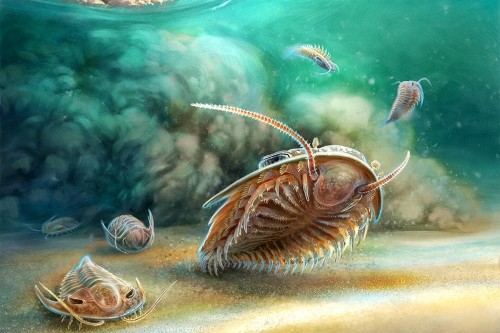Some of the most perfectly preserved trilobite fossils ever found have revealed details of the extinct arthropod unknown until now.
The new specimens, which were killed and fossilised quickly when volcanic ash smothered them underwater more than 500 million years ago, show details never before seen in any trilobite, despite the millions of fossils gathered and studied over the past two centuries.
The trilobites, which are from the Cambrian period, have been the subject of research by an international team of scientists, led by Professor Abderrazak El Albani, geologist based at University of Poitiers and originally from Morocco. This international team include co-authors Harry Berks and Philip Donoghue from the University of Bristol’s School of Earth Sciences.
They discovered clustering of specialised leg pairs around the mouth giving a clearer picture of how trilobites fed.
Harry Berks explained: “The head and body appendages had an inward-facing battery of dense spines like those of horseshoe crabs, manipulating and tearing prey or scavenged carcasses as they were moved forwards to the mouth.
“The mouth, a narrow slit behind a fleshy lobe called a labrum, known in living arthropods, has never been so clearly seen in a trilobite before.”
The appendages at the edge of the mouth have curved bases like spoons and are so small that they went undetected in less perfectly preserved fossils.
It was widely thought that trilobites had three pairs of head appendages behind their long antennae but both Moroccan species show that there were four pairs.
The Moroccan trilobites date to the Cambrian Period, about 515 million years ago. The fossils are found in rock composed of volcanic ash, deposited on the shallow seafloor on which the trilobites lived. The trilobites, and even tiny ‘lamp shells’ (brachiopods) that attached to them via a delicate stalk in life, were killed by the hot, suffocating ash and were fossilised very quickly when the ash that encased them transformed to rock. The outer surface of the trilobites, all of their legs and the lamp shells hitching a ride on them were moulded as impressions in the volcanic rock, while the trilobites’ digestive tract was preserved after it filled with ash.
To see how these impressions in the rock looked just after the trilobites died, the team used a high-resolution X-ray micro-tomography (XRµCT). X-rays detect the difference in density between the rock in which a trilobite was moulded and the empty (air) space where the body was before it was obliterated. Co-author, Harry Berks, used computer modelling of X-ray slices through the fossils to study the anatomy of the entire body of the trilobites in 3-dimensions, freed from the surrounding rock. Harry said “The computer work is pain-staking but it’s definitely been worth it. These trilobites look so alive, it’s almost as though they could crawl out of the rock.”
The ‘Pompei’ trilobites are so remarkable because they are not flattened or deformed like many fossils and every leg is arranged as it was in life, with even small spines and sensory bristles along the joints of the legs preserved. “I’ve been studying trilobites for nearly 40 years, but I never felt like I was looking at live animals as much as I have with these ones”, said co-author Greg Edgecombe from the Natural History Museum, London.
The study sheds new light on the anatomy and biology of the long-vanished trilobites but also signals the enormous potential for volcanic ash deposited in shallow marine settings as a setting to search for exceptionally preserved fossils. Co-author Philip Donoghue said: “No one expects to find fossils in volcanic rocks but our study shows that volcanic ash deposits are definitely worth a look. Who knows what secrets remains to be discovered in these understudied rocks?”
Trilobites are a completely extinct kind of arthropod, the group of jointed-legged animals that includes more than a million species of insects, crabs, spiders, and centipedes alive today. They are one of the most abundant and diverse lifeforms in fossil deposits of the Palaeozoic Era, surviving from 521 million years ago to 250 million years ago. Palaeontologists have described more than 20,000 species of trilobites, ranging in body length from less than two millimetres to more than 90 centimetres. Most trilobite species are only known from their hard exoskeleton (like a lobster’s shell), but only about 30 species preserve a pair of antennae and/or pairs of two-branched legs under the head shield and each segment of the body.
The paper:
‘Rapid volcanic ash entombment reveals the 3D anatomy of Cambrian trilobites’ by El Albani A, Donoghue P.C.J, Berks, H.O et al in Science.
>>> Read full article>>>
Copyright for syndicated content belongs to the linked Source : Hacker News – https://www.bristol.ac.uk/news/2024/june/prehistoric-pompeii.html
